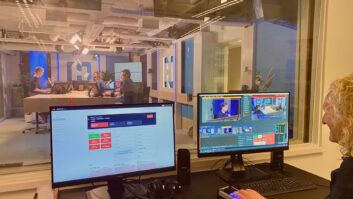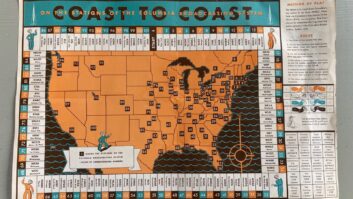The author is vice president of content and marketing for Aha by Harman, an interactive service that uses cloud-based technology to organize content from the Web into personalized “radio stations.”
This commentary is the second article in a series about radio’s role in the evolving world of consumer electronics.

Chia-Lin Simmons
Analysts report that the average American spends one to two hours in the car every day. Assuming they are following the law and putting away their phone, that’s up to 10 hours per week that they are completely disconnected from the Internet: no Facebook or Twitter, no Google, no Siri, no Huffington Post or podcasts or Yelp. All the rich content services that — thanks to smartphones — consumers have come to expect wherever they go are simply out of reach at 65 miles per hour.
But this is all changing. Analysts also estimate that by the year 2030 there will be 1 billion Web-ready cars on the road. This means that radio broadcasters will be competing harder for listener attention than they ever have before.
Because of its five- to eight-year development cycles, the car industry lags behind the ever-changing Web and mobile industries in terms of integrating digital media. But car makers see that access to a hot, Web-based service like Pandora or Facebook is suddenly as important to car buyers as gas mileage and paint color, and they are racing to get Web-enabled vehicles on showroom floors now, not five to eight years from now.
Furthermore, young drivers expect their listening experience in the car to be personalized and at the ready. After all, they have grown up with TiVo and email, with Facebook their main source of news and with on-demand music wherever they go.
All of these trends mean major change is afoot for the radio industry.
CONNECTED CAR MARKET
The market for connected cars is crowded and complex.
Connectivity strategies vary greatly from one car maker to the next. Some automakers are trying to build their own “app stores” following on the success of smartphone app stores. Others think that mirroring the smartphone screen on the dashboard is the answer. Still others are collaborating to build an industry standard solution for all to adopt.
At Aha, we provide a 65-mph media experience specifically for the unique in-car environment. This means the service must work so well that a driver will choose to put down the phone during a drive and not pick it up again until they exit the vehicle.
It’s almost universally accepted that drivers need to focus on driving, not on navigating complex menus, flipping between apps or attempting other tasks that will create cognitive overload or take their eyes off the road. In-dash app stores for drivers present challenges for driving: It’s impossible to mimic the smartphone on the dashboard without seriously distracting drivers.
Any platform that can be adopted by all automakers easily and affordably will succeed in the long run, allowing publishers, including radio broadcasters, to easily reach millions of drivers with one effort. Requiring radio broadcasters to build a different app for each automaker, then support every app with regular updates, bug fixes and new features in perpetuity is simply unrealistic and prohibitively expensive. Not more than a handful of major media companies would be able to undertake that task, leaving drivers wanting more.
PROVEN PARADIGM

Subaru is one of 10 automakers that plan to integrate Aha into their infotainment platforms by year-end. When the phone is connected to a compatible in-vehicle entertainment system, the user’s favorite Aha stations become radio preset buttons. Here, Aha displays an NPR feature program.
So, given all of these challenges, what does the future hold?
In order to move forward, the car industry must look back to the paradigm that has proven safe and easy to use for drivers for nearly 100 years: the car radio.
After extensive research, the U.S. Department of Transportation’s National Highway Traffic Safety Administration has established that radio is the benchmark for appropriate infotainment while driving. With simple touch buttons, some personalization via “presets” and limited interactivity, it makes sense that the automotive industry should modernize, not abandon, the car radio model.
Solutions must also be scalable across the industry and around the world. Similar to how iOS and Android have emerged as the development platforms of choice in mobile, automakers will need to rally around no more than two or three standard platforms so that drivers can benefit from a healthy ecosystem of diverse publishers.
With more than 10 leading automakers adopting Aha this year alone, it is an early leader in the race to be one of the “standard” platforms for connectivity.
As more winning strategies emerge and drivers gain access to a world of content in the car, new opportunities for terrestrial radio stations become evident.
First, each station will have instant access to a global audience. For example, an AM bluegrass station in Jacksonville, Fla., with a small but loyal listenership can suddenly reach potentially millions of drivers as far away as South Africa, Germany or Australia.
Second, highly scaled distribution platforms level the playing field between radio broadcasters and Internet radio companies. An FM station manager who would never have the resources or expertise to build, distribute and maintain their own mobile app to dozens of different car manufacturers will not be left out.
For these two reasons alone — global audiences and a level playing field — radio broadcasters are beginning to embrace the connected car and see it not as a threat to their business, but an opportunity to reach new listeners on a global scale.
THE AHA MODEL
So, how do radio station managers and engineers take advantage of this new technology and get their content distributed globally? It may sound intimidating and highly technical, but the leading platforms must also make the process easy and affordable for content publishers if they want to offer the broadest content choices for listeners.
At Aha, we do the work for our content partners.
First, radio station engineers provide Aha’s content team with the Application Programming Interfaces, digital audio streams and/or RSS feeds that they already use for their mobile or Internet services. If they don’t already have an API, Aha introduces the partners to services that help them transform their broadcasts into easy-to-access streaming standards that we grab and bring onto our cloud-based system.
Once established, content partners update their services and feeds as they normally would, and Aha manages the rest. There is no cost involved for stations, no special hardware and no additional software for radio stations to update. Aha engineers do the technical work via a cloud-based system, even incorporating station and show logos and other rich visuals to make each station’s brand shine on the car’s head unit. Adding new channels from a network of stations also is simple once the API or data feed has been established with the content provider.
Aha is a free platform and service for both stations and consumers.
There is no denying that tomorrow’s car radio experience will look very different from what most of us grew up with. Consumers’ expectations for personalization, broad content choices, social networking and on-demand controls are all here to stay.
AM and FM stations and the talented individuals who create them are not going away — there will always be a need for original, local content published and/or curated by humans. But radio station managers must adapt to remain competitive and compelling.
The good news is that emerging platforms like Aha make it easy to get into connected cars and reach listeners where FM and AM transmissions can never go. If broadcast engineers and radio publishers embrace these new models, the sky is the limit.
Comment on this or any Radio World article. Email[email protected].
###










